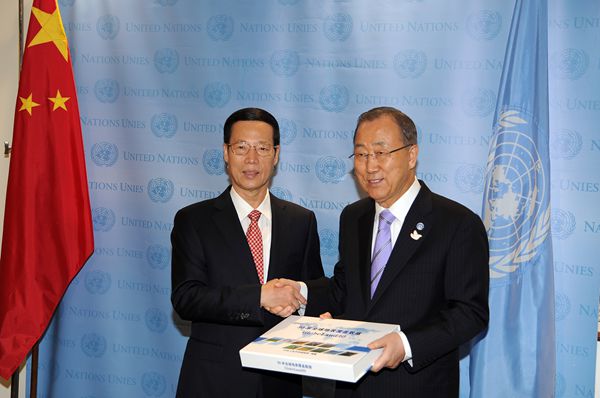Emission reduction – China's commitment and progress
- By Li Wuzhou
 0 Comment(s)
0 Comment(s) Print
Print E-mail China.org.cn, July 17, 2015
E-mail China.org.cn, July 17, 2015
|
|
|
Zhang Gaoli (L), Chinese vice premier and President Xi Jinping’s special envoy, and United Nations Secretary-General Ban Ki-moon mark China’s donation of a global land cover dataset at 30-meter resolution to the United Nations in New York on September 22, 2014. [Photo: China Today] |
China has been a proactive participant in confronting environmental issues since the early 1990s, when the United Nations Framework Convention on Climate Change was established and the UN-led international climate change negotiations started to tackle climate challenges. Among its commitments over the years since then is a pledge to reduce emissions. China has since strived to fulfill its responsibilities and obligations.
A commitment of real worth
The biggest developing country in the world, China is still in the process of urbanization and industrialization. Hence, it faces a dilemma between socioeconomic development and ecological protection.
In spite of grave challenges, China understands well the importance of protecting the well-being of humankind and future generations, and has established environmental protection as one of its basic national policies. In 2007, China became the first developing country to formulate and implement a national scheme to deal with climate change. Two years later, it announced a 40 to 45 percent cut in carbon emission intensity by 2020 compared with 2005 levels. At the same time, this binding index has been integrated into the country's medium-term and long-term plans for the national economy and social development. Relevant supervision and assessment systems are also in force.
In 2012, China confirmed that ecological health was equally important as other social facets like the economy, politics, and culture. Nationwide pollution control accelerated.
At the UN Climate Summit in New York in September 2014, as Special Envoy of President Xi Jinping, Vice Premier Zhang Gaoli said that China would set forth the post-2020 action target as soon as possible and strive to achieve the peaking of carbon dioxide emissions by an early date.
His words were echoed two months later when China unveiled its climate change goals after 2020, which include an increase in the share of non-fossil fuels in primary energy consumption to around 20 percent by 2030. According to the U.S. Brookings Institution, this target will require China to deploy a generation capacity that is close to the total current electricity generation capacity in the U.S.
Effective emission reduction
In order to deal with the hazardous smog that has hit many provinces and municipalities, China unveiled the Airborne Pollution Prevention and Control Action Plan in September 2013.
On his very first day last February as newly appointed Minister for Environmental Protection, Chen Jining reviewed the previous year's list of measures to tackle air pollution and smog. The data revealed that over six million vehicles that did not meet emissions standards were scrapped in 2014, surpassing the sum of the three preceding years. Meanwhile, 55,000 coal-fired boilers were shut down, and the newly-increased gas consumption reached 2.5 billion cubic meters due to the nationwide project of switching from coal to natural gas. Desulfurization, denitrification, and dust elimination devices for coal-fueled power generators were upgraded, with respective capacities of 130 million kw, 260 million kw, and 240 million kw. Moreover, 2,080 cases involving environmental violations were reported to the police nationwide, twice the sum of the previous decade. At a press conference for this year's National People's Congress (NPC) in March, Chen pointed out: "No country in the world is making such great efforts as China to combat air pollution within so short a time. We are adopting stringent measures to tackle formidable challenges."
In addition, an action plan to improve the country's water quality was issued in April this year, the targets of which include shutting down small and outdated factories in such sectors as paper making, tanning, printing and dyeing, electroplating, and insecticides by the end of 2016. According to the action plan, special supervision and rectification programs would be introduced covering 10 major polluting industries like papermaking, coking, nitrogenous fertilizer, and nonferrous materials.
These measures have proved successful. In 2014, the PM 2.5 density dropped by 11.1 percent on average in 74 Chinese cities that had adopted a new air quality standard. In the region around the capital, the figure decreased by 12.3 percent.







Go to Forum >>0 Comment(s)